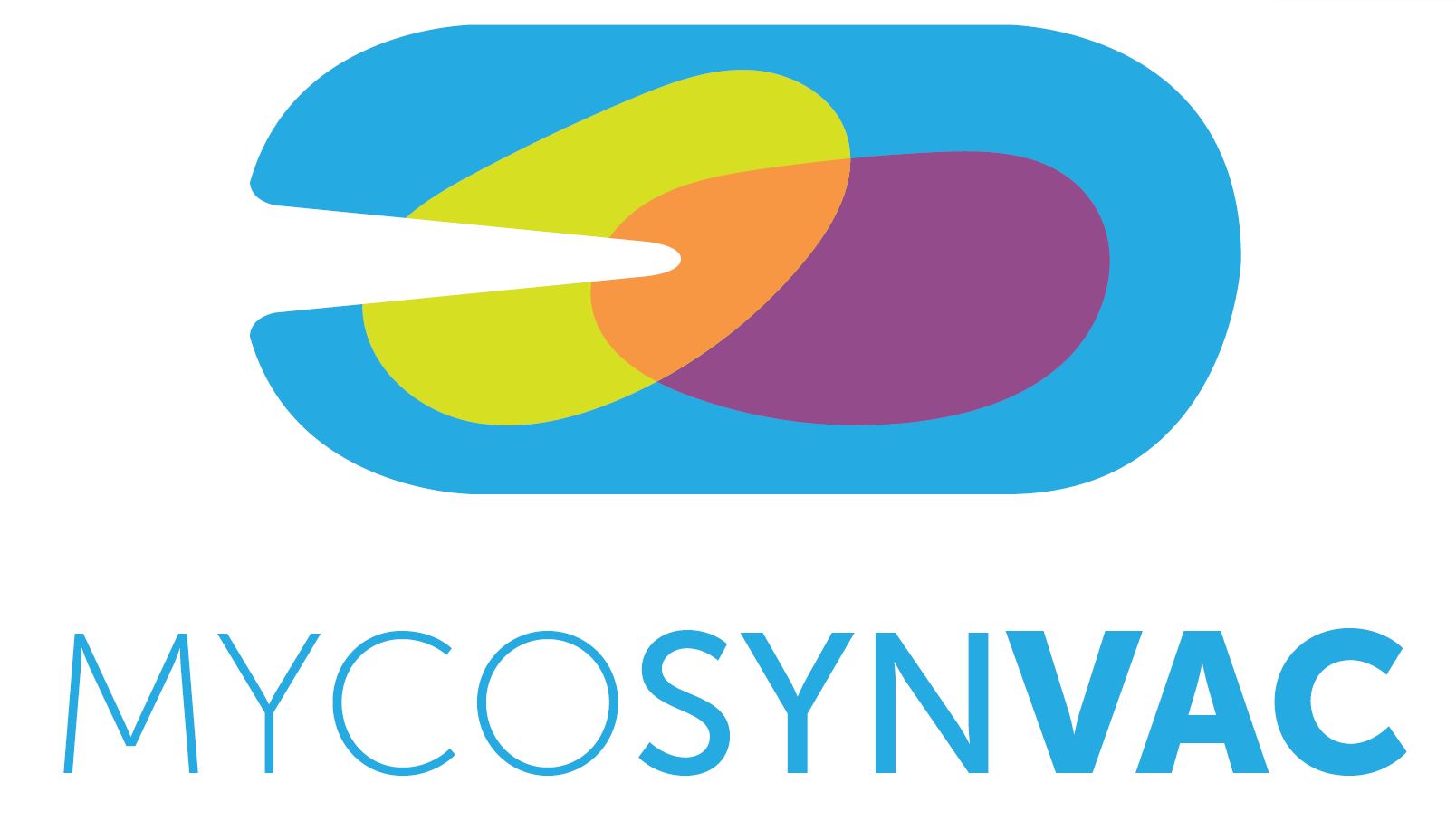
H2020 MycoSynVac Project: Engineering Mycoplasma pneumoniae as a broad-spectrum animal vaccine
- Type Project
- Status Filled
- Execution 2015 -2020
- Assigned Budget 8.056.677,00 €
- Scope Europeo
- Main source of financing Horizon 2020
- Project website MycoSynVac
WUR developed a dynamic whole-cell model for M. pneumoniae metabolism and, based on these models, developed a genome-scale constraint-based model for M. hyopneumoniae for vaccine optimization. WUR also implemented its metabolic models to assess the genome-wide metabolic capabilities of several Mycoplasmas for the purpose of designing a tailored vaccine portfolio.
CRG developed two genome engineering methods for M. pneumoniae. The result was a non-pathogenic chassis that can survive in mouse lungs as long as WT Mycoplasma pneumoniae, does not trigger lung injury, and exhibits a reduced inflammatory response. This chassis can express heterologous proteins and protein adjuvants for vaccination on its surface. The genes essential for survival in mouse lungs that cannot be eliminated from the chassis were determined.
ICL designed, optimized, and tested its biosecurity circuits in the WT strain, which showed good elimination efficiency when activated. Furthermore, the integration of redundancy improves the biosecurity system. Very promising results have been obtained in pairwise competitions that tested the different biosecurity systems developed in vivo using mouse models. The biosecurity circuits were also transformed into chassis strains. In this case, the circuits had to be reoptimized, and not all cases were successful. The best strain generated is a CV2 with two copies of the reoptimized KS1 circuits.
INRA developed a method called Genomic Transfer-Recombinase-Mediated Cassette Exchange (GT-RMCE). This new technology allows for large-scale genomic modifications at specific M. pneumoniae loci. It allows for insertion and replacement of large DNA fragments and gene deletions, and could be extended to introduce point mutations. All these new tools made it possible to inactivate known M. pneumoniae virulence factors and led to the construction of prototype vaccine chassis.
ATG completed the selection of candidate peptides for inclusion in chimeric proteins for vaccine production; 44 were selected for Mycoplasma hyopneumoniae and 23 for Mycoplasma bovis. Furthermore, analysis of 64 porcine reproductive and respiratory syndrome virus (PRRSV) strains by peptide microarrays allowed the selection of an additional 20 candidate peptides for this virus. The peptides were combined into 8 chimeric proteins for M. hyopneumoniae, 6 for M. bovis, and 4 for PRRSV.
Merck conducted eight large animal experiments to evaluate the various vaccines generated in the project. Expression of heterologous antigens on the surface of an attenuated M. pneumoniae chassis, grown in serum-free medium, is safe in food animals as an inactivated vaccine and produces seroconversion to all exposed antigens. Preliminary results also indicate that the chassis variants could be safe as a live attenuated vaccine, as the bacteria cannot be detected in body parts other than the injection site. Additional animal experiments would be necessary to conclude on the efficacy of these vaccines.
The work conducted by UCPH on societal concerns has also established that, while there is generally broad acceptance of the use of a synthetic cattle vaccine in Europe, there are significantly different perceptions of such a vaccine across countries. Their internal dialogue activities helped our researchers reflect on how their work might be perceived by other relevant stakeholders.
Biofaction developed a wide variety of different types of public engagement, ranging from in-person interactions at science cafés, high school visits, and public science communication events to online activities such as five-character animation videos, a short science documentary, and the science game 'Battle for Cattle' for web and mobile devices.
Each year, infections caused by Mycoplasma species in poultry, cattle, and pigs cause multimillion-dollar losses in the US and Europe. There is no effective vaccine against many Mycoplasmas that infect pets, humans, and farm animals. Furthermore, most Mycoplasmas are difficult to culture, requiring complex media that include animal serum. Consequently, even in cases for which effective vaccines exist (specifically, M. hyopneumoniae in pigs and M. gallisepticum and M. synoviae in poultry), the vaccine production process is complex.
The primary objective of this project is to design a universal Mycoplasma chassis that can be implemented as a single or multiple vaccine in various animal hosts. Specifically, in this project, we will focus on the development of attenuated or inactivated vaccines against two Mycoplasma pathogens: M. hyopneumoniae (swine) and M. bovis (cattle), and a combined vaccine against M. hyopneumoniae and Zika fever syndrome virus (PRSSV) (swine).
To achieve this overall goal, the MycoSynVac project has the following specific objectives: vaccine design, chassis engineering, and optimization of large-scale production, all while taking into account the future exploitation of the developed technology and addressing the ethical concerns that synthetic biology may raise.
Mycoplasmas are the smallest free-living microorganisms without a cell wall. Their lack of a cell wall makes them resistant to many common antibiotics. Each year, mycoplasma infections in poultry, cattle, and pigs result in multimillion-dollar losses in the US and Europe. Currently, vaccines are available against M. hyopneumoniae in pigs and M. gallisepticum and M. synoviae in poultry.
However, there is no vaccination against many mycoplasma species that infect pets, humans, and farm animals (i.e., M. bovis infection in cows). In many cases, mycoplasma species are difficult to grow in axenic cultures, and those that do grow require a complex medium containing animal serum.
In the large-scale production of mycoplasma species for vaccination, in addition to the high cost of animal serum, the most important issue is the high irreproducibility of the production process and the potential for contamination with animal viruses. All of this together highlights the needs of the European industry: i) a defined, cost-effective, and reproducible medium free of animal serum; and ii) a universal Mycoplasma chassis that can be used in vaccination against Mycoplasma species, as well as against any other pathogen.
M. pneumoniae is an ideal starting point for the design of such a vaccine chassis. It has a small genome (860 kb) and is probably the organism with the most comprehensive systems biology data obtained to date. Through genomic comparison, metabolic modeling, and rational genome engineering, we will create a vaccine chassis that will be introduced into an industrial production process.
The process will be guided by the world's second-largest animal vaccination company (MSD), as well as by an SME specializing in peptide visualization and screening. This will ensure the exploitation and commercialization of our work, helping to maintain Europe's privileged position in this field. Our ultimate goal is to meet the needs of the livestock industry, addressing ethical issues and foreseeable risks, and preparing effective dissemination and training materials for the public.
The MycoSynVac project was highly ambitious and utilized a truly innovative approach to vaccine production: a universal vaccination chassis based on M. pneumoniae, capable of efficient and reproducible growth in a defined serum-free medium.
The consortium brought together cutting-edge knowledge and resources in Mycoplasma, modeling, synthetic biology, antigenic epitope determination, vaccine production and commercialization, as well as other important areas such as dissemination and ethical aspects. The project's main impacts center on four core areas: synthetic biology, industry-academia relations, public engagement, and innovation capacity at the European level. MycoSynVac had a positive impact on all partners:
- For the CRG, MycoSynVac facilitated the creation of a spin-off company called Pulmobiotics, which aims to treat the respiratory disease ventilator-associated pneumonia (VAP) in humans using the chassis as a delivery system.
- MSD gained access to new technologies developed at ATG, which were used by MSD for research unrelated to MycoSynVac. They also gained expertise in mycoplasma biology and synthetic biology, allowing MSD to maintain its leadership in the vaccine market.
- INRA increased its collaborations with leading European laboratories and companies in the animal health sector. Furthermore, it gained greater awareness of social issues thanks to the UCPH and Biofaction.
- WUR gained insight into host-microbe interactions and strengthened its position in the agri-food and healthcare sectors.
- The ICL patented the development of its biosecurity circuits.
- The ATG developed new methods to analyze hundreds of surface antigens and viral protein families on high-density peptide microarrays for antibody responses in the search for optimal epitopes. Cooperation with MSD and the CRG and the integration of their datasets allowed them to gain valuable experience in planning, executing, and evaluating data analysis processes.
- The UCPH developed competencies to conduct cross-border social science studies in Europe and broaden its focus to apply empirical ethics.
- Biofaction gained additional visibility (e.g., for science animation clips and science game development) and established additional contacts for science communication channels (YouTube channels, podcasts, etc.).
- FUNDACIO CENTRE DE REGULACIO GENOMICA (CRG-CERCA)







